Figures & data
FIG. 1 Current design of the collection and thermal desorption (CTD) cell provides in-situ calibrations of TAG via an integrated injection port. Fixed-volume injections of varying concentrations of authentic standards in solution are deposited near the impaction region of the collection cell on the same passivated surface as used for aerosol collection.

TABLE 1 Subset of authentic standards used for TAG calibration during summer and fall Riverside field studies. The tracking standard was injected regularly throughout both study periods while the auxiliary standards were infrequently injected and primarily serve to confirm MS compound identification through retention times
FIG. 2 Comparison of calibrated TAG masses to NIST assay values for select PAH compounds on one or two RM8785 filter punches.
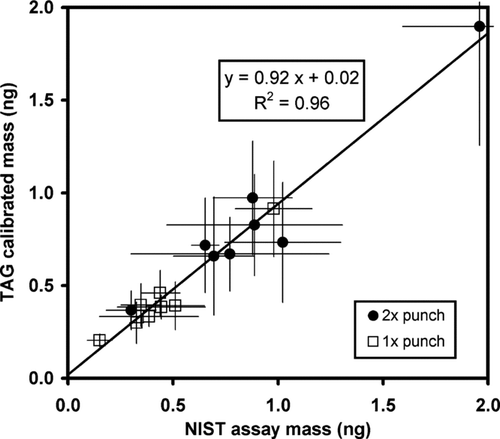
TABLE 2 Comparison of calibrated TAG masses to NIST assay values of select PAH compounds on RM8785 filter punches
TABLE 3 Compounds contained in the Tracking standard
FIG. 3 Relationship of injection repeatability (RSD) versus the ratio of LOQ to the individual compound injection mass level M. Compounds that elute before hexadecane (i.e., those listed above the shaded region of ) where excluded. For these less-volatile species, the baseline precision for calibration standards can be taken as the limit of LOQ/M∼0, which is the intercept of the regression line = 1.3% RSD.
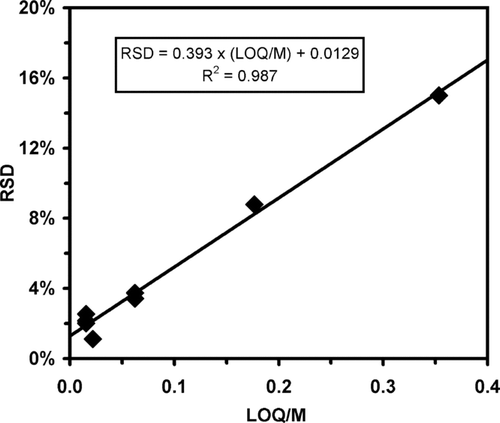
FIG. 4 Fall instrument response trends are shown for four selected tracking standard compounds used in this analysis. Plotted is the detector peak area divided by each compound's average response versus hour of study. Mean single ion areas are 6.7 × 105 (cholestane), 4.0 × 106 (chrysene), 2.2 × 106 (eicosane), and 4.2 × 106 (octacosane). These compounds demonstrate a consistent, downward trend in MS response as a function of time. For a uniformly distributed subset of the tracking standard data, the cholestane FID data show no significant trend. Different filled symbols indicate distinct standard solutions. Drift regressions shown exclude the first set of standard solutions (triangles) due to uncertainty in that standard's concentrations.
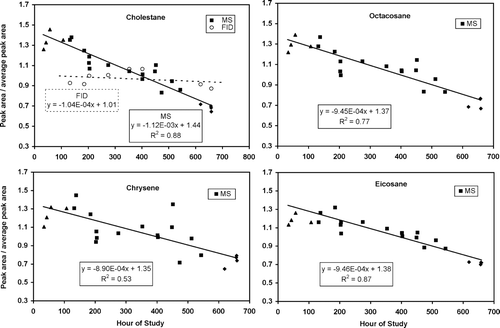
FIG. 5 Summer instrument response trends are shown for four selected tracking standard compounds used in this analysis. Plotted is the detector peak area divided by each compound's average response versus hour of study. Mean single ion areas are 8.4 × 105 (cholestane), 6.3 × 106 (chrysene), 2.6 × 106 (eicosane), and 5.6 × 106 (octacosane). These compounds demonstrate a consistent, downward trend in MS response as a function of time. For a uniformly distributed subset of the tracking standard data, the cholestane FID data shows no significant trend. Different filled symbols are for two standard concentration levels with the indicated stock dilution ratio. The more dilute response data was scaled up to the more concentrated level by application of a preliminary calibration using the more concentrated subset of data.
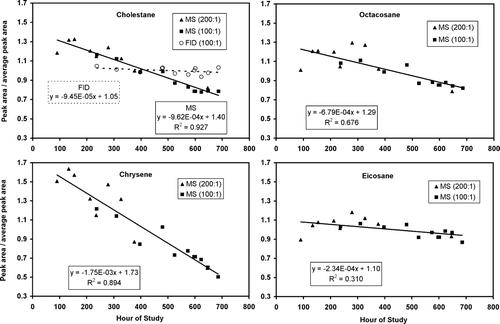
FIG. 6 Time-independent calibration of TAG for four of the tracking standard compounds for the Summer SOAR study. Non-linear fits (solid lines) are shown to be superior to linear fits (broken lines) for all four compounds, especially near the limits of detection of the instrument (insets). Vertical spread in calibration points indicates residual variation of data after de-trending.

FIG. 7 Relative response factors for n-alkanes defined as the ratio of the single ion peak areas (57 m/z) for compound Cn to the reference compound eicosane (C20) for summer and fall periods. Sensitivity to mass level is indicated at both the low and high volatility ends of the carbon number spectrum. Response factors from the alkane auxiliary standard (triangles, squares) provide the complete range of response for TAG and are in general agreement with similar ratios obtained from the multipoint calibration data using C16, C20, and C28 in the tracking standard (circles), shown with 1-σ error bars, over the indicated mass injection levels.
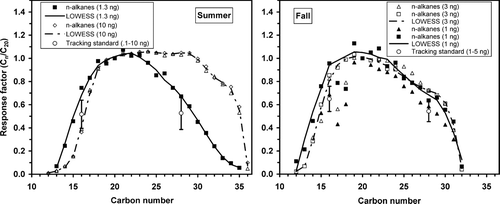
TABLE 4 Relative response factors for PAHs in the EPA auxiliary standard relative to the tracking standard compound chrysene, as defined by Equation (Equation4). R i, chy is the response at the 1 ng injection level, and R i, chy is the average response over a range of injection levels
FIG. 8 Calibrated TAG response for octacosane, chrysene, and the sum of two hopanes, during the fall study. The calibration for the tracking standard cholestane was applied to each of the hopane responses with a relative response factor prior to summing. Gaps greater than 2 h are shown with line breaks indicating when calibrations or other interruptions of normal operation occurred.
